Tillage Methods Change Nitrogen Distribution and Enzyme Activities in Maize Rhizosphere and Non-Rhizosphere Chernozem in Jilin Province of China
Abstract
:1. Introduction
2. Materials and Methods
2.1. Research Design
2.2. Soil Sampling
2.3. Test and Analyze Methods
3. Results
3.1. Total N Dynamics in Maize Soil with Various Tillage Methods
3.2. Dynamic Change of NH4+-N and NO3−-N in Chernozem under Different Tillage Methods
3.3. Dynamic Change of Urease, Catalase and Alkaline Phosphatase Enzymes Activities in Rhizosphere and Non-Rhizosphere Soil with Various Tillage Methods
4. Discussion
4.1. Compare Influence of Different Tillage Methods on N Distribution in Rhizosphere and Non-Rhizosphere Soil
4.2. Elucidate the Enzyme Activity in Rhizosphere Soil and Non-Rhizosphere Soil with Various Tillage Methods
5. Conclusions
Author Contributions
Funding
Data Availability Statement
Conflicts of Interest
References
- Marschner, P.; Crowley, D.; Yang, C. Development of specific rhizosphere bacterial communities in relation to plant species, nutrition, and soil type. Plant Soil. 2004, 261, 199–208. [Google Scholar] [CrossRef]
- Haghighi, B.J.; Alizadeh, O.; Firoozabadi, A.H. The role of plant growth-promoting rhizobacteria (PGPR) in sustainable agriculture. Adv. Environ. Biol. 2011, 5, 3079–3083. [Google Scholar]
- Olahan, G.; Sule, I.; Garuba, T.; Salawu, Y. Rhizosphere and non-rhizosphere soil mycoflora of Corchorus olitorius (Jute). Sci. World J. 2016, 11, 23–26. [Google Scholar]
- Li, Z.; Zu, C.; Wang, C.; Yang, J.; Yu, H.; Wu, H. Different responses of rhizosphere and non-rhizosphere soil microbial communities to consecutive Piper nigrum L. monoculture. Sci. Rep. 2016, 6, 35825. [Google Scholar] [CrossRef] [PubMed]
- Van der Voort, M.; Kempenaar, M.; Van Driel, M.; Raaijmakers, J.M.; Mendes, R.J. Impact of soil heat on reassembly of bacterial communities in the rhizosphere microbiome and plant disease suppression. Ecol. Lett. 2016, 9, 375–382. [Google Scholar] [CrossRef] [PubMed]
- LeFevre, G.H.; Hozalski, R.M.; Novak, P. Root exudate enhanced contaminant desorption: An abiotic contribution to the rhizosphere effect. Environ. Sci. Technol. 2013, 47, 11545–11553. [Google Scholar] [CrossRef]
- Hinsinger, P.; Bengough, A.G.; Vetterlein, D.; Young, L.M. Rhizosphere: Biophysics, biogeochemistry, and ecological relevance. Plant Soil. 2009, 321, 117–152. [Google Scholar] [CrossRef]
- Zhang, F.; Shen, J.; Zhang, J.; Zuo, Y.; Li, L.; Chen, X. Rhizosphere processes and management for improving nutrient use efficiency and crop productivity: Implications for China. Adv. Agron. 2010, 107, 1–32. [Google Scholar]
- Zhang, F.; Shen, J.; Li, L.; Liu, X. An overview of rhizosphere processes related to plant nutrition in major cropping systems in China. Plant Soil. 2004, 260, 89–99. [Google Scholar] [CrossRef]
- Zhang, F.; Shen, J.; Jing, J.; Li, L.; Chen, X. Rhizosphere processes and management for improving nutrient use efficiency and crop productivity. In Molecular Environmental Soil Science at the Interfaces in the Earth’s Critical Zone; Springer: Berlin/Heidelberg, Germany, 2010; Volume 107, pp. 52–54. [Google Scholar] [CrossRef]
- Deng, S.; Tabatabai, M. Effect of tillage and residue management on enzyme activities in soils: III. Phosphatases and arylsulfatase. Biol. Fertil. Soils 1997, 24, 141–146. [Google Scholar] [CrossRef]
- Xing, X.; Zhang, L. Review of the studies on silicon nutrition of plants. Chin. Bull. Bot. 1998, 15, 33–40. [Google Scholar]
- Ren, J.; Guo, J.; Xing, X.; Qi, G.; Yuan, Z. Preliminary study on yield increase effects and yield increase mechanism of silicate fertilizer on maize. Sci. Agric. 2002, 10, 86–87. [Google Scholar]
- Chen, S.; Zheng, X.; Wang, D.; Chen, L.; Xu, C.; Zhang, X. Effect of long-term paddy-upland yearly rotations on rice (Oryza sativa) yield, soil properties, and bacteria community diversity. Sci. World J. 2012, 2012, 279641. [Google Scholar] [CrossRef] [PubMed]
- Xu, X.; Liu, X.; He, P.; Johnston, A.M.; Zhao, S.; Qiu, S.; Zhou, W. Yield gap, indigenous nutrient supply, and nutrient use efficiency for maize in China. PLoS ONE 2015, 10, e0140767. [Google Scholar] [CrossRef] [PubMed]
- Ju, X.T.; Kou, C.L.; Zhang, F.; Christie, P. Nitrogen balance and groundwater nitrate contamination: Comparison among three intensive cropping systems on the North China Plain. Environ. Pollut. 2006, 143, 117–125. [Google Scholar] [CrossRef]
- Zhang, F.; Cui, Z.; Chen, X.; Ju, X.; Shen, J.; Chen, Q.; Liu, X.; Zhang, W.; Mi, G.; Fan, M. Integrated nutrient management for food security and environmental quality in China. Adv. Agron. 2012, 116, 1–40. [Google Scholar]
- Joshi, S.; Mohapatra, B.; Mishra, J. Microbial Soil Enzymes: Implications in the Maintenance of Rhizosphere Ecosystem and Soil Health. Microorg. Sustain. 2018, 3, 179–192. [Google Scholar]
- Yuan, J.; Li, Y.; Shan, Y.; Tong, H.; Zhao, J. Effect of magnesium ions on the mechanical properties of soil reinforced by microbially induced carbonate precipitation. J. Mater. Civ. Eng. 2023, 35, 4023413. [Google Scholar] [CrossRef]
- Burns, R.G. Enzyme activity in soil: Location and a possible role in microbial ecology. Soil Biol. Biochem. 1982, 14, 423–427. [Google Scholar] [CrossRef]
- Caldwell, B.A. Enzyme activities as a component of soil biodiversity: A review. Pedobiologia 2005, 49, 637–644. [Google Scholar] [CrossRef]
- Hamido, S.A.; Kpomblekou, A.K. Cover crop and tillage effects on soil enzyme activities following tomato. Soil Till. Res. 2009, 105, 269–274. [Google Scholar] [CrossRef]
- Mu, X.; Zhao, Y.; Liu, K.; Ji, B.; Guo, H.; Xue, Z.; Li, C. Responses of soil properties, root growth, and crop yield to tillage and crop residue management in a wheat–maize cropping system on the North China Plain. Eur. J. Agron. 2016, 78, 32–43. [Google Scholar] [CrossRef]
- Das, S.K.; Varma, A. Role of enzymes in maintaining soil health. Soil Biol. 2010, 22, 25–42. [Google Scholar]
- Zhang, G.; Zhao, Z.; Yin, X.; Zhu, Y. Impacts of biochars on bacterial community shifts and biodegradation of antibiotics in an agricultural soil during short-term incubation. Sci. Total Environ. 2021, 771, 144751. [Google Scholar] [CrossRef] [PubMed]
- Yang, Y.; Dong, M.; Cao, Y.; Wang, J.; Tang, M.; Ban, Y.J.F. Comparisons of soil properties, enzyme activities and microbial communities in heavy metal contaminated bulk and rhizosphere soils of Robiniapseudoacacia L. in the Northern foot of Qinling Mountain. Forests 2017, 8, 430. [Google Scholar] [CrossRef]
- Tabiehzad, H.; Cayci, G.; Rezaeieh, K.A. The effects of tillage methods on soil aggregation and crop yields in a wheat-corn rotation under semi-arid conditions. Solid Earth Discuss. 2017, 2017, 1–20. [Google Scholar] [CrossRef]
- Polat, R.; Sağlam, R.; Aydemir, S.; Çıkman, A.J. Effects of different tillage methods on soil physical properties under second crop sesame in the Harran plain, southeast Turkey. Asian J. Sci. 2006, 5, 613–618. [Google Scholar]
- Iqbal, M.; Ali, A.; Rizwanullah, M. Residual effect of tillage and farm manure on some soil physical properties and growth of wheat (Triticumaestivum L.). Int. J. Agric. Biol. 2005, 7, 54–57. [Google Scholar]
- Rashidi, M.; Keshavarzpour, F. Effect of different tillage methods on grain yield and yield components of maize (Zea mays L.). Int. J. Agric. Biol. 2007, 9, 274–277. [Google Scholar]
- Zhang, L.; Wang, J.; Fu, G.; Zhao, Y. Rotary tillage in rotation with plowing tillage improves soil properties and crop yield in a wheat-maize cropping system. PLoS ONE 2018, 13, e0198193. [Google Scholar] [CrossRef]
- Pierce, F.; Fortin, M.C.; Staton, M. Periodic plowing effects on soil properties in a no-till farming system. Soil Sci. Soc. Am. J. 1994, 58, 1782–1787. [Google Scholar] [CrossRef]
- López-Fando, C.; Pardo, M.J.S.; Research, T. Changes in soil chemical characteristics with different tillage practices in a semi-arid environment. Soil Till. Res. 2009, 104, 278–284. [Google Scholar] [CrossRef]
- Linh, T.; Sleutel, S.; Elsacker, S.; Guong, V.; Khoa, L.; Cornelis, W. Inclusion of upland crops in rice-based rotations affects chemical properties of clay soil. Soil Use Manag. 2015, 31, 313–320. [Google Scholar] [CrossRef]
- Devine, S.; Markewitz, D.; Hendrix, P.; Coleman, D. Soil aggregates and associated organic matter under conventional tillage, no-tillage, and forest succession after three decades. PLoS ONE 2014, 9, e84988. [Google Scholar] [CrossRef] [PubMed]
- Li, J.; Wang, L.; Li, J.; Shang, J. Effects of rotational tillage on soil water content and crop yield of spring maize system on Weibei dryland. Trans. Chin. Soc. Agric. Eng. 2015, 31, 110–118. [Google Scholar]
- Liu, X.; Liu, J.; Xing, B.; Herbert, S.; Meng, K.; Han, X.; Zhang, X. Effects of long-term continuous cropping, tillage, and fertilization on soil organic carbon and nitrogen of black soils in China. Commun. Soil Sci. Plant Anal. 2005, 36, 1229–1239. [Google Scholar] [CrossRef]
- Du, Y.; Niu, W.; Zhang, Q.; Cui, B.; Gu, X.; Guo, L.; Liang, B. Effects of Nitrogen on Soil Microbial Abundance, Enzyme Activity, and Nitrogen Use Efficiency in Greenhouse Celery under Aerated Irrigation. Soil Sci. Soc. Am. J. 2018, 82, 606–613. [Google Scholar] [CrossRef]
- Rütting, T.; Aronsson, H.; Delin, S. Efficient use of nitrogen in agriculture. Nutr. Cycl. Agroecosyst. 2018, 110, 1–5. [Google Scholar] [CrossRef]
- Sutton, M.A.; Howard, C.M.; Erisman, J.W.; Billen, G.; Bleeker, A.; Grennfelt, P.; Van Grinsven, H.; Grizzetti, B. The European Nitrogen Assessment: Sources, Effects, and Policy Perspectives; Cambridge University Press: Cambridge, UK, 2011. [Google Scholar]
- Xiao, Y.; Gong, W.; Zhao, M.; Zhang, M.; Lu, N. Surface-engineered prussian blue nanozymes as artificial receptors for universal pattern recognition of metal ions and proteins. Sens. Actuators B Chem. 2023, 390, 134006. [Google Scholar] [CrossRef]
- Alvarez, R. A review of nitrogen fertilizer and conservation tillage effects on soil organic carbon storage. Soil Use Manag. 2005, 21, 38–52. [Google Scholar] [CrossRef]
- Liu, X.T.; Wu, X.P.; Liang, G.P.; Zheng, F.J.; Zhang, M.N.; Li, S.P. A global meta-analysis of the impacts of no-tillage on soil aggregation and aggregate-associated organic carbon. Land Degrad. Dev. 2021, 32, 5292–5305. [Google Scholar] [CrossRef]
- Mondal, S.; Chakraborty, D. Soil nitrogen status can be improved through no-tillage adoption particularly in the surface soil layer: A global meta-analysis. J. Clean. Prod. 2022, 366, 132874. [Google Scholar] [CrossRef]
- Li, T.; Xie, H.X.; Ren, Z.H.; Hou, Y.T.; Zhao, D.Q.; Wang, W.Y.; Wang, Z.T.; Liu, Y.; Wen, X.X.; Han, J.; et al. Soil tillage rather than crop rotation determines assembly of the wheat rhizobacterial communities. Soil Res. 2023, 226, 105588. [Google Scholar] [CrossRef]
- Habib, H.; Verzeaux, J.; Nivelle, E.; Roger, D.; Lacoux, J.; Catterou, M.; Hirel, B.; Dubois, F.; Tetu, T. Conversion to no-till improves maize nitrogen use efficiency in a continuous cover cropping system. PLoS ONE 2016, 11, e0164234. [Google Scholar] [CrossRef]
- Soon, Y.; Malhi, S.; Wang, Z.; Brandt, S.; Schoenau, J. Effect of seasonal rainfall, N fertilizer and tillage on N utilization by dryland wheat in a semi-arid environment. Nutr. Cycl. Agroekosyst. 2008, 82, 149–160. [Google Scholar] [CrossRef]
- Josa, M.R.; Ginovart, G.M.; Solé, A. Effects of two tillage techniques on soil macroporosity in a sub-humid environment. Int. Agrophys. 2010, 24, 139–147. [Google Scholar]
- Hester, E.R.; Harpenslager, S.F.; Van Diggelen, J.M.; Lamers, L.L.; Jetten, M.S.; Lüke, C.; Lücker, S.; Welte, C.U. Linking nitrogen load to the structure and function of wetland soil and rhizosphere microbial communities systems. Ecol. Evol. Sci. 2018, 3, e00214–e00217. [Google Scholar]
- Gao, Y.; Tan, Z.Y.; Wang, H.; Zhu, Y.N. Nitrogen fertilization and the rhizosphere effect on nitrogen cycling: A meta-analysis. Appl. Soil Ecol. 2023, 186, 104788. [Google Scholar] [CrossRef]
- Dick, R.; Sandor, J.; Eash, N. Soil enzyme activities after 1500 years of terrace agriculture in the Colca Valley, Peru. Agric. Ecosyst. Environ. 1994, 50, 123–131. [Google Scholar] [CrossRef]
- Gupta, V.; Germida, J. Distribution of microbial biomass and its activity in different soil aggregate size classes as affected by cultivation. Soil Biol. Biochem. 1988, 20, 777–786. [Google Scholar] [CrossRef]
- Balota, E.L.; Kanashiro, M.; Filho, A.C.; Andrade, D.S.; Dick, R.P. Soil enzyme activities under long-term tillage and crop rotation systems in subtropical agro-ecosystems. Braz. J. Microbiol. 2004, 35, 300–306. [Google Scholar] [CrossRef]
- Bendick, A.K.; Dick, R.P. Field management effects on soil enzyme activities. Soil Biol. Biochem. 1999, 31, 1471–1479. [Google Scholar] [CrossRef]
- Mohammadi, K.; Heidari, G.; Karimi Nezhad, M.T.; Ghamari, S.; Sohrabi, Y. Contrasting soil microbial responses to fertilization and tillage systems in canola rhizosphere. Saudi J. Biol. Sci. 2012, 19, 377–383. [Google Scholar] [CrossRef] [PubMed]
- Heidari, G.; Mohammadi, K.; Sohrabi, Y. Responses of soil microbial biomass and enzyme activities to tillage and fertilization systems in soybean (Glycine max L.) production. Front. Plant Sci. 2016, 7, 1730. [Google Scholar] [CrossRef]
- Li, Y.; Song, D.; Liang, S.; Dang, P.; Qin, X.; Liao, Y.; Siddique, K.H.M. Effect of no-tillage on soil bacterial and fungal community diversity: A meta-analysis. Soil Till. Res. 2020, 204, 104721. [Google Scholar] [CrossRef]
- Silva, A.; Babujia, L.; Franchini, J.; Ralisch, R.; Hungria, M.; Guimar, E. Soil structure and its influence on microbial biomass in different soil and crop management systems. Soil Till. Res. 2014, 142, 42–53. [Google Scholar] [CrossRef]
- Stanislawska-Glubiak, E.; Korzeniowska, J. Effect of soil tillage systems on nutrient concentration in winter wheat plants. J. Food Agric. Environ. 2012, 10, 1353–1355. [Google Scholar]
- Derpsch, R.; Friedrich, T.; Kassam, A.; Li, H. Current status of adoption of no-till farming in the world and some of its main benefits. Int. J. Agric. Biol. Eng. 2010, 3, 1–25. [Google Scholar]
- Bhatt, R.; Arora, S.; Busari, M. Zero tillage for sustaining land and water productivity in northern India. J. Soil Water Conserv. 2017, 16, 228–233. [Google Scholar] [CrossRef]
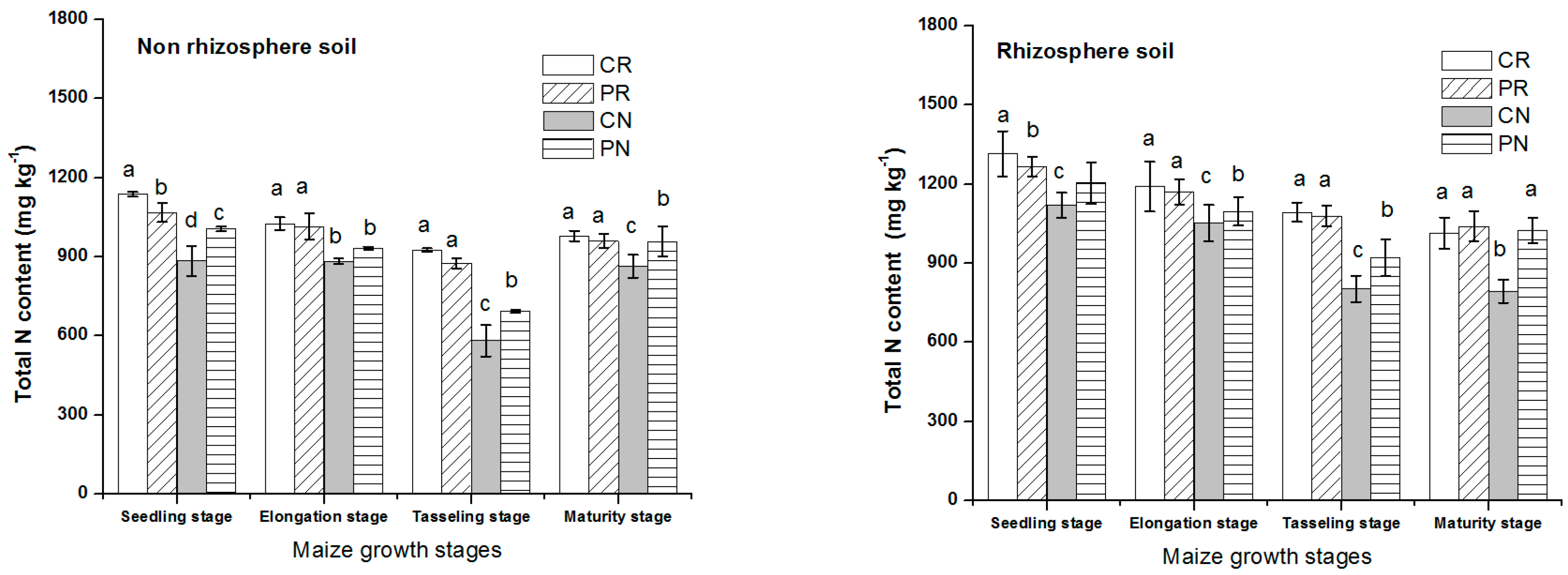
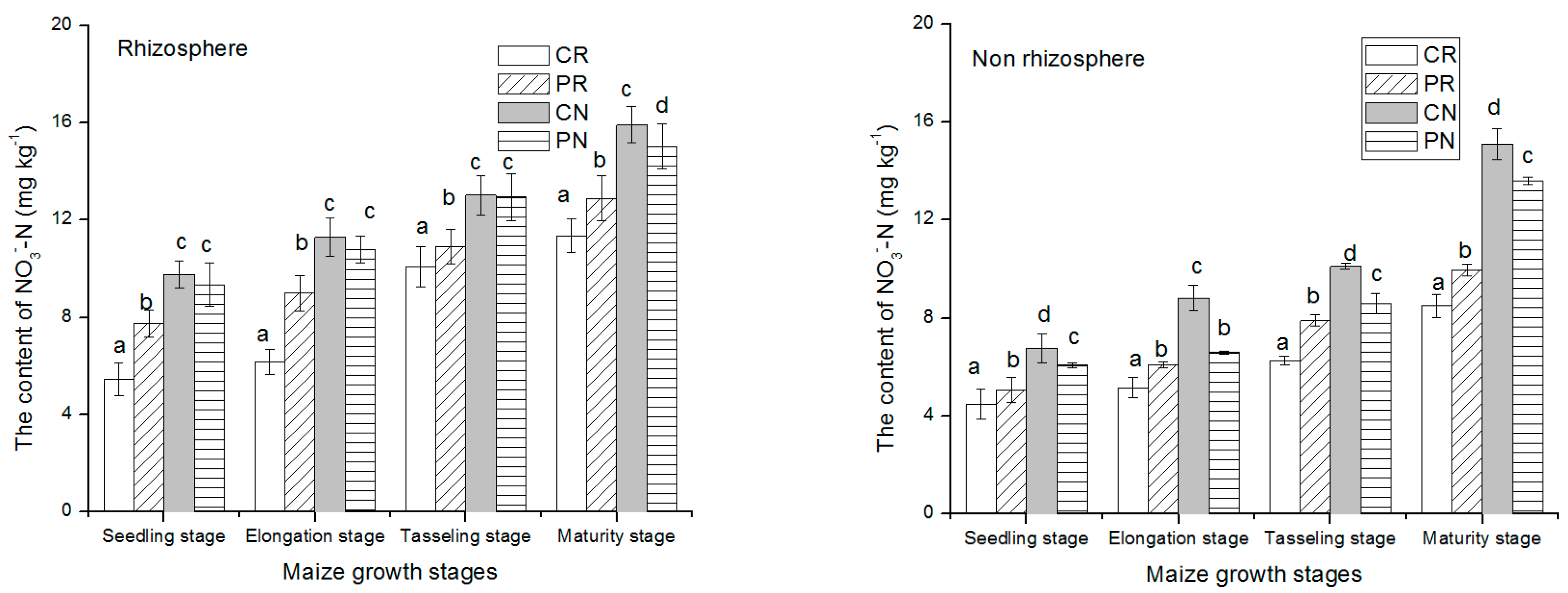
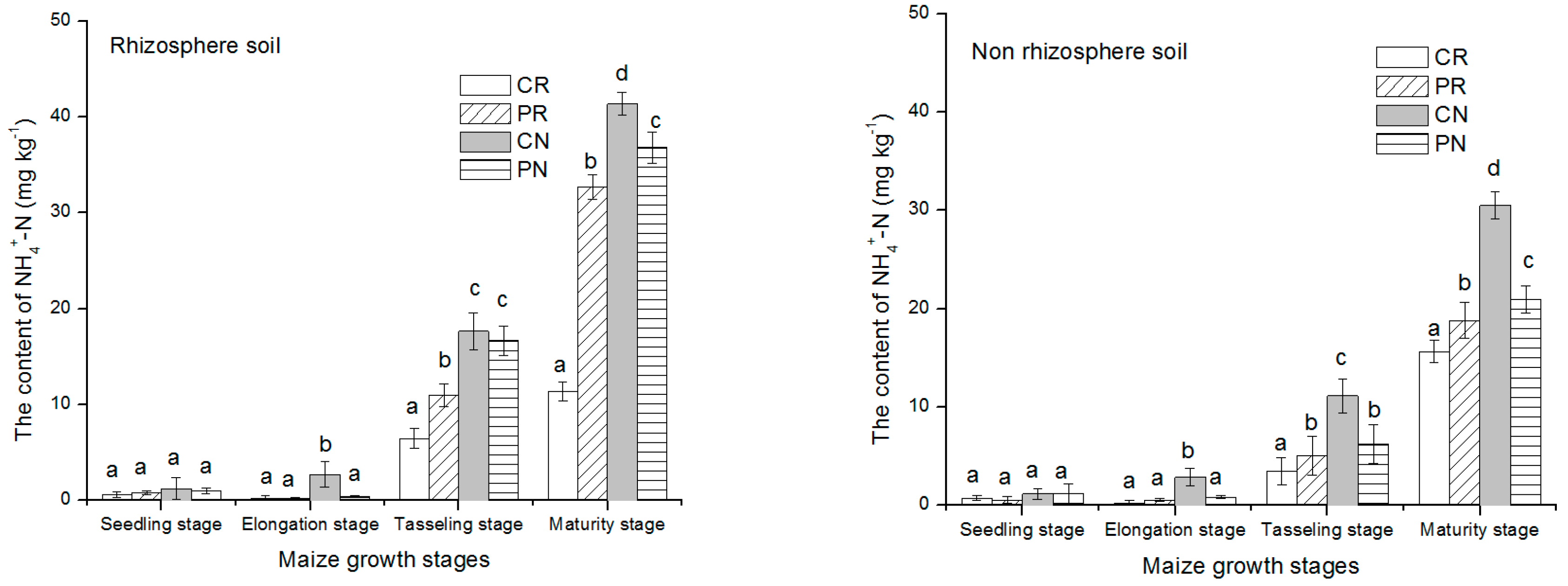
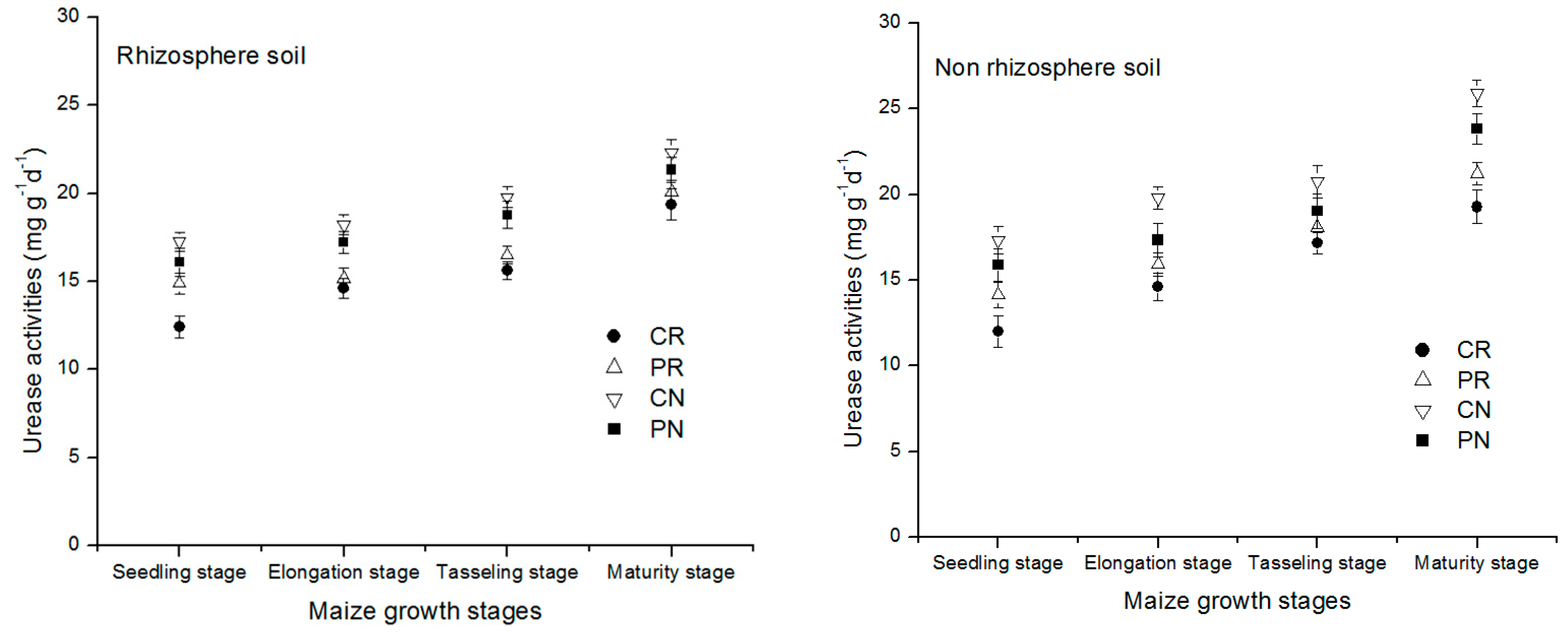
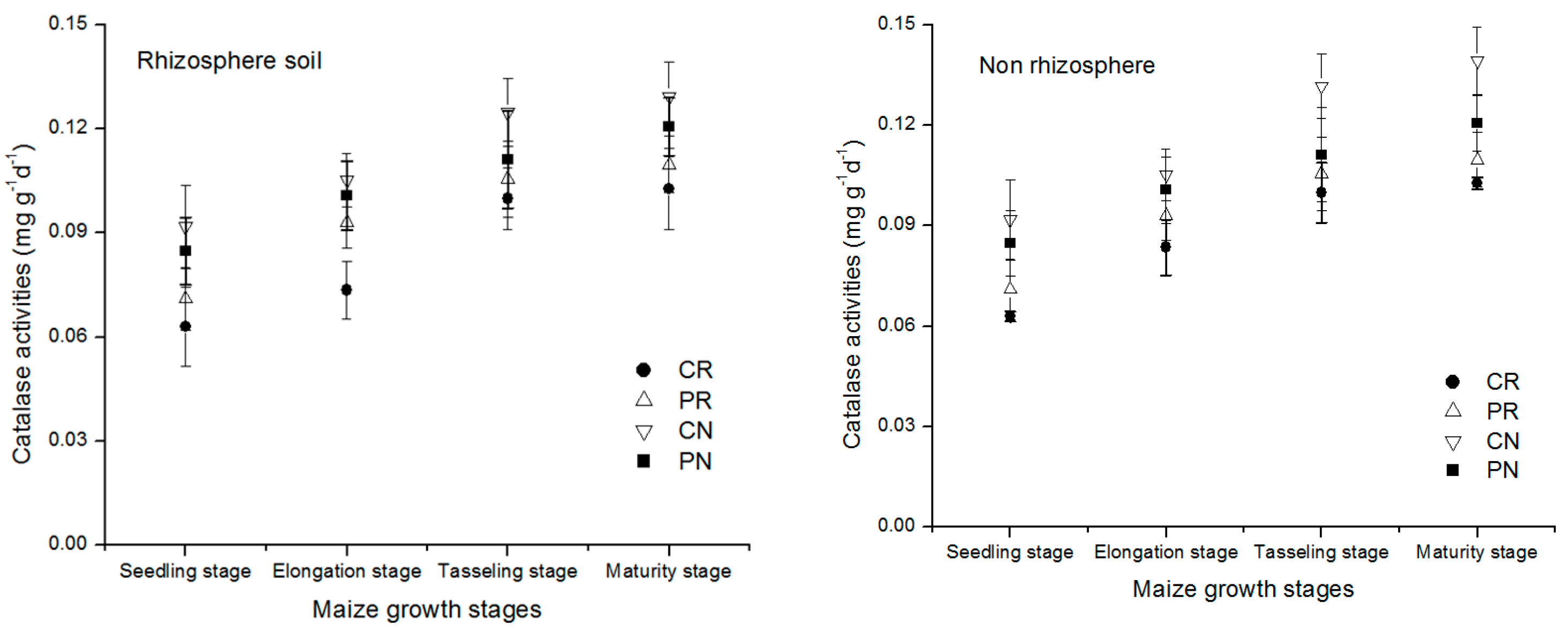
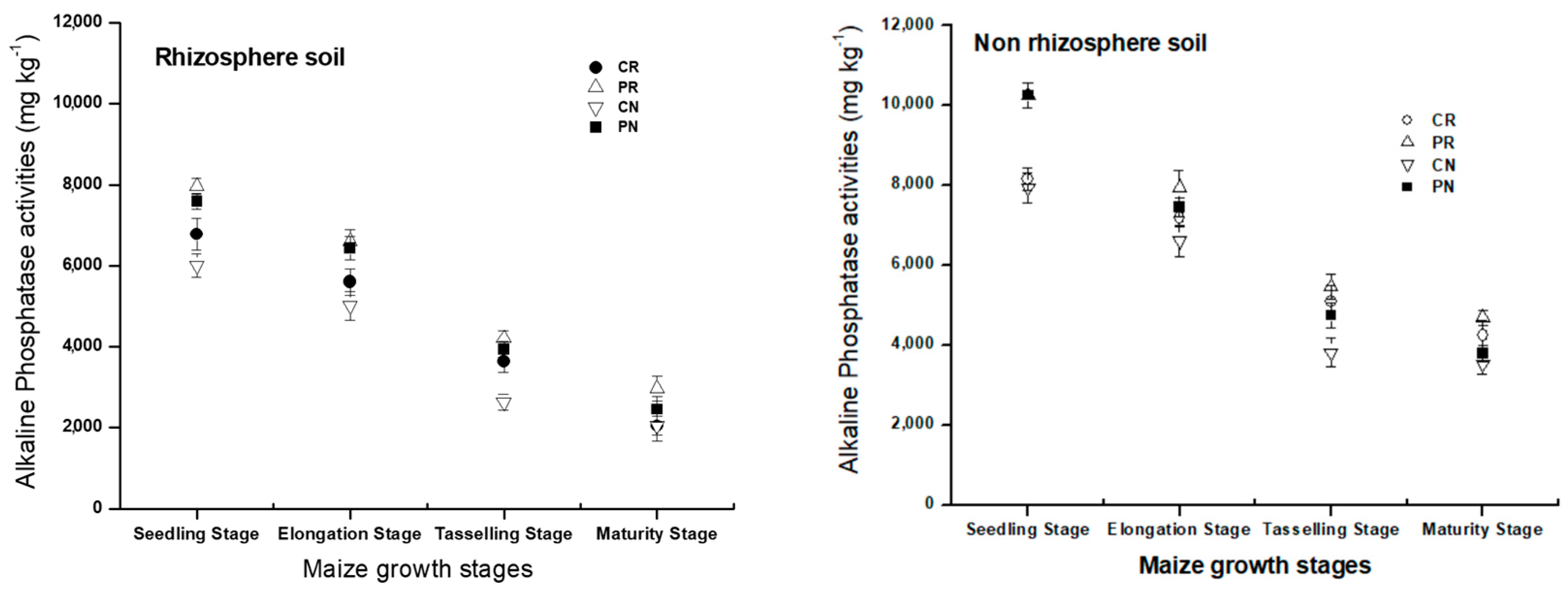
| Characteristics | Value |
|---|---|
| Organic matter | 16.97g·kg−1 |
| pH | 7.10 |
| Available P | 34.64 mg·kg−1 |
| Total P | 462.08 mg·kg−1 |
| Total N | 1.52g·kg−1 |
| Alkaline N | 65.83 mg·kg−1 |
| Available K | 75.99 mg kg−1 |
| Total K | 21,606.16 mg·kg−1 |
| Soil bulk density | 1.61 g·cm−3 |
| Soil texture | Black Sandy loam |
| Type of the soil | Black Chernozem |
Disclaimer/Publisher’s Note: The statements, opinions and data contained in all publications are solely those of the individual author(s) and contributor(s) and not of MDPI and/or the editor(s). MDPI and/or the editor(s) disclaim responsibility for any injury to people or property resulting from any ideas, methods, instructions or products referred to in the content. |
© 2023 by the authors. Licensee MDPI, Basel, Switzerland. This article is an open access article distributed under the terms and conditions of the Creative Commons Attribution (CC BY) license (https://creativecommons.org/licenses/by/4.0/).
Share and Cite
Huang, N.; Zhao, X.; Guo, X.; Sui, B.; Liu, J.; Wang, H.; Li, J. Tillage Methods Change Nitrogen Distribution and Enzyme Activities in Maize Rhizosphere and Non-Rhizosphere Chernozem in Jilin Province of China. Processes 2023, 11, 3253. https://doi.org/10.3390/pr11113253
Huang N, Zhao X, Guo X, Sui B, Liu J, Wang H, Li J. Tillage Methods Change Nitrogen Distribution and Enzyme Activities in Maize Rhizosphere and Non-Rhizosphere Chernozem in Jilin Province of China. Processes. 2023; 11(11):3253. https://doi.org/10.3390/pr11113253
Chicago/Turabian StyleHuang, Ning, Xingmin Zhao, Xinxin Guo, Biao Sui, Jinhua Liu, Hongbin Wang, and Jialin Li. 2023. "Tillage Methods Change Nitrogen Distribution and Enzyme Activities in Maize Rhizosphere and Non-Rhizosphere Chernozem in Jilin Province of China" Processes 11, no. 11: 3253. https://doi.org/10.3390/pr11113253
APA StyleHuang, N., Zhao, X., Guo, X., Sui, B., Liu, J., Wang, H., & Li, J. (2023). Tillage Methods Change Nitrogen Distribution and Enzyme Activities in Maize Rhizosphere and Non-Rhizosphere Chernozem in Jilin Province of China. Processes, 11(11), 3253. https://doi.org/10.3390/pr11113253









